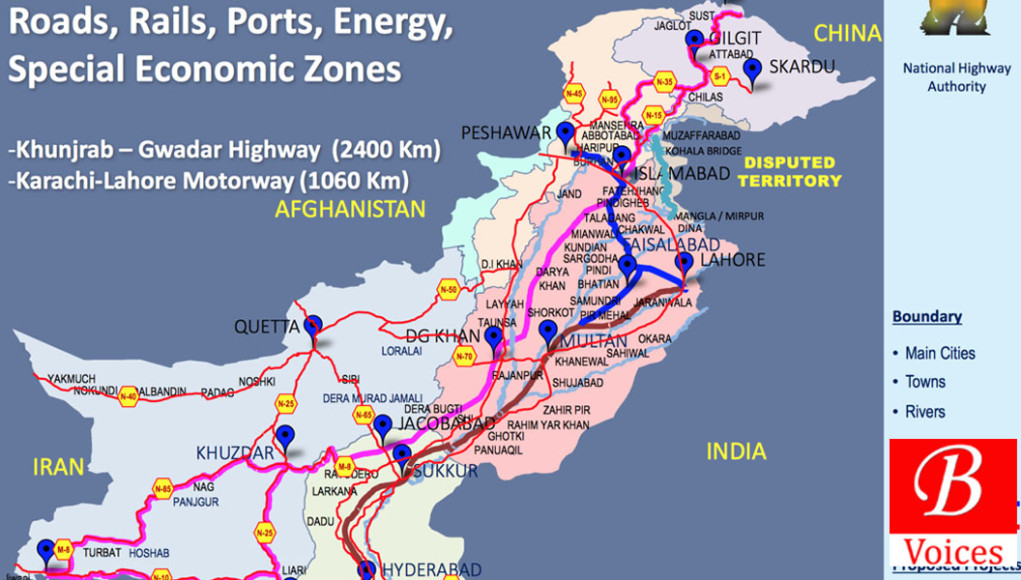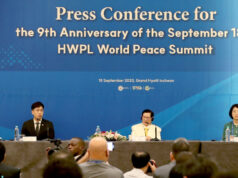Adnan Aamir
Last month a meeting of China-Pakistan Economic Corridor (CPEC) Joint Working Group on Transport Infrastructure took place in Islamabad. In that meeting, Pakistan sought financing for the western route of CPEC. Almost four and half years after its inception, there is no financing framework for the western route of this mammoth project, which was once dubbed as a ‘game-changer’ for Pakistan. Is CPEC’s western route just a myth used to deceive Balochistan and Khyber Pakhtunkhwa (KP)?
In 2013, it was revealed for the first time that China will be investing tens of billions of dollars to develop an economic corridor in Pakistan. The initial maps of the corridor shared with the media showed that the proposed economic corridor ran from Gwadar in Balochistan to Kashghar in Xinjiang via Balochistan and KP. This was good news for the underdeveloped western provinces of Pakistan, which expected an infrastructure uplift due to the CPEC economic corridor.
In April 2015, the Chinese president visited Islamabad and signed CPEC agreements with the government of Pakistan. Once the jubilations of the visit by President Xi Jinping were over, people following CPEC closely realized that the PML-N government had silently shifted the corridor from west to east to benefit its support base of Punjab. This was a shock for politicians of Balochistan who actively raised this issue and termed it a grave injustice.
In order to diffuse criticism, PML-N’s Ahsan Iqbal coined the term ‘western route’
Awami National Party (ANP) held a conference on this issue in May 2015. Other parties also made a huge deal of this issue. In order to diffuse the criticism, PML-N’s Ahsan Iqbal coined the term ‘western route.’ He argued that there will be three main alignments of CPEC: eastern, central and western. In these circumstances, an All Parties Conference (APC) was held with Prime Minister Nawaz Sharif in the chair in May 2015. In that APC it was announced that the western route of the CPEC would be built as a priority to the eastern route. The promise by Nawaz Sharif resulted in temporarily cooling off the debate.
In December 2015, Sharif claimed to make good on his promise. He inaugurated what was claimed to be the western route of CPEC at Zhob, Balochistan. During the inauguration ceremony, he was flanked by Maulana Fazalur Rehman, Mehmood Khan Achakzai of PKMAP and Hasil Bizenjo of National Party. Religious and nationalist allies of Nawaz Sharif commended him for allowing Balochistan and KP benefit from CPEC. After a few months, it was revealed that this was nothing but deception. The highway project Sharif inaugurated was funded by Asian Development Bank and it had nothing to do with CPEC.
Although the aforementioned allies of Nawaz Sharif remained silent on this deception, political parties in opposition and the civil society in Balochistan and KP made huge noise on this issue. They called out the PML-N government for their deception and for favouring the Punjab at the cost of Balochistan and KP. From that point, PML-N’s spin doctor Ahsan Iqbal churned the myth of the western route and denied the truth.
In April 2016, the Panama Papers scandal came to light. Unfortunately, the Sharif family was also named in the scandal. This resulted in a campaign by the PTI and their backers to get rid of Sharif. Due to these developments, the PML-N lost its focus on CPEC but it still pumped life into the western route myth. Later, Sharif was ousted in July 2017 and his party lost the July 2018 elections in a controversial manner. With the removal of the PML-N government, the issue of CPEC in general and its western route, in particular, went to cold storage.
However, last month it once again came to light when the PTI government requested China to fund the western route project. This proved that so far, no funding was made available for this so-called western route by China under the CPEC framework. This news would have never made it out of the meeting room if the PML-N was still in charge. However, things have changed for CPEC after the arrival of the PTI government.
The deception by the PML-N government in the name of western route cost Balochistan dearly. Balochistan missed out on infrastructure development, which could have been funded through CPEC. Every now and then, scores of people die in highway accidents in Balochistan due to narrow single-lane highways. If the western route had been built, then major highways of Balochistan would have already been upgraded. On the other hand, the development work on the eastern route has made huge progress. Karachi-Lahore Motorway, the centre stone of eastern route, is near completion. This motorway will result in infrastructure and socio-economic development in Sindh and the Punjab at the cost of underdeveloped Balochistan and KP.
Now the PTI government is making a fresh push for CPEC. This also involves getting funding for the western route. However, it is too late to benefit Balochistan because the early harvest projects phase of CPEC has already passed and now China can not commit to major funding in the western route when it has already funded the eastern route.
The western route is a case study of how a biased attitude of the federal government and its development-related organs keep Balochistan backward. It also shows that the nationalist politicians of Balochistan easily become partners-in-crime with the federal government, if their vested interests are protected. Under these circumstances, the deprivations of Balochistan will always be used as a bargaining chip by politicians of Balochistan and not to bring real development in the province.
Originally published in The Friday Times
Share your comments!








